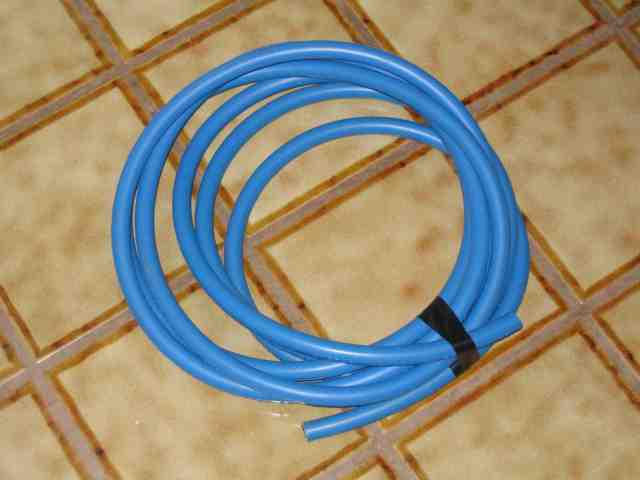
Speaking of fluid hose, I am using Parker Hi-Temp Push-Lok synthetic hose, type 836-6. It is rated at 250 PSI and 300F which is adequate for the pressure and temperature that the tranny fluid should produce while they flow around the TJ in an attempt to get cooled off. I was originally going to use steel braided hose (at least before I walked into the speed shop) but after discussing my application with one of the resident gear heads, I opted to give this a try.
My initial hose selection was totally based on abrasion issues that may be seen in an off-highway application. The gear head told me that while that is something to consider, the regular steel braided hose that I was considering was constructed using a natural rubber inner material, which will crack and rot down the road. The inner liner of this hose is extruded synthetic rubber and is surrounded by a fiber braid reinforcement layer, also impregnated with synthetic rubber. The elastomer covering provides very good flexibility and resistance to abrasion. In fact, this 3/8″ diameter hose provides for a 3″ bend radius. The price was reasonable enough at $3.50 per foot.
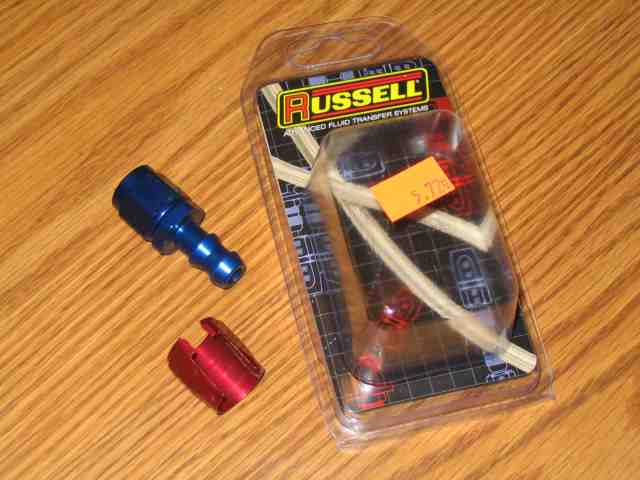
Once the hose selection was made, it was time for some fittings. Since it was my intent to plumb everything with AN fittings, I got some -6 straight and 90 degree fittings. The Russell part # for the -6 fitting is 624010.
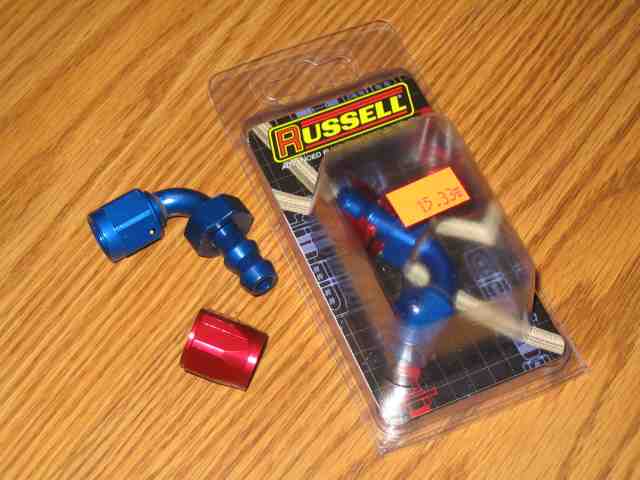
While the Russell Twist-Lok straight fittings were under $6 each, the 90 degree fittings pounded the wallet at more than $15 each. OUCH! The Russell part # for this fitting is 624160.
There are obviously other options you can take in regards to your cooling setup. NPT hose barbs with regular transmission return hose is a much cheaper route than I took. But I wanted easy screw on/off fittings for maintenance purposes. As I write this, nothing is installed and I may find that my cooling configuration doesn’t do the job. Rerouting hard lines is virtually impossible once it is bent….the same is not at all true with the components I have chosen.
I will also mention that I did not shop around for the best price for the AN fittings. Comparing those I purchased at the speed shop to a couple of on-line stores, I found that no one vendor had consistently lower prices…..the 90 degree fitting cost less from vendor A but the straight fitting was more. One thing to remember, if you want to shop around for the best prices, make sure that the shipping charges from multiple vendors doesn’t negate your savings.

And just for the record, not all AN fittings are expensive. These 1/2″ NPT to -6AN fittings were just under $6 for two. (It makes it a little easier to absorb those $15 fittings.)
AW-4 Transmission Swap
Since the radiator was out of the running for transmission fluid cooling, I had to come up with something else. Auxiliary coolers are often added to vehicles when they see trailer towing or other heavy duty service. These are usually mounted up front in the air stream, just behind the vehicle’s grill. Mounting my cooler there would only add to the heat load of the radiator (sucking hotter air through the radiator won’t make it cool better) so I decided to use two stacked plate fluid coolers to handle the tranny fluid cooling chores.
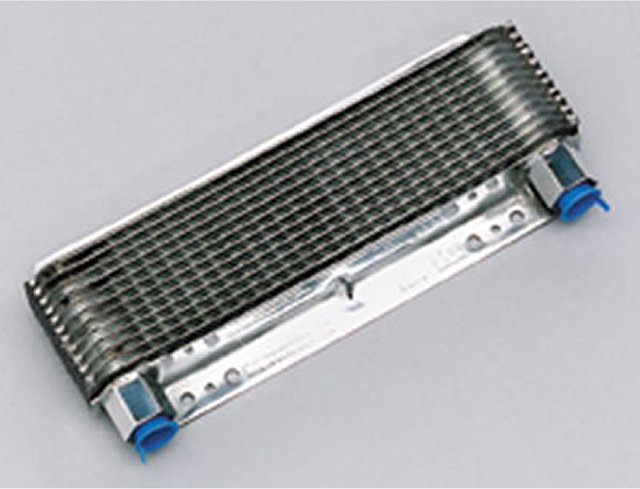
The first stacked plate cooler will act as a pre-cooler. I call it my pre-cooler since the hot transmission fluid will encounter this cooler first upon leaving the AW-4. It is my intention to mount this cooler in such a fashion as to get some air flow across the plates while the TJ is moving. (yeah I know, not exactly a novel idea) What I mean is that I hope this cooler will reduce the fluid temperature enough, during routine city/highway driving, such that the second cooler has less to do. (more on that below) The core size of this unit is 2.5″x11″x1.5″, which is not exceptionally large compared to many. I ordered it from www.summitracing.com , part number BMM-70265. Cost was about $46.
I chose a stacked plate cooler design over the less expensive tube and fin type as they are more suited for off-highway use. Stones and pebbles will have less of a tendency to damage this type of cooler. If you’ve ever mounted/used a tube and fin cooler, you know it takes next to nothing to bend a bunch of the fins and thus reduce the air flow through the unit. While I plan to mount the two coolers in the safest place I can, I still have to remember that the TJ is going to be playing in the rocks and brush. The stacked plate coolers usually have integrated mounting tabs/brackets while tube and fin units end up getting held in place with zip ties and such.
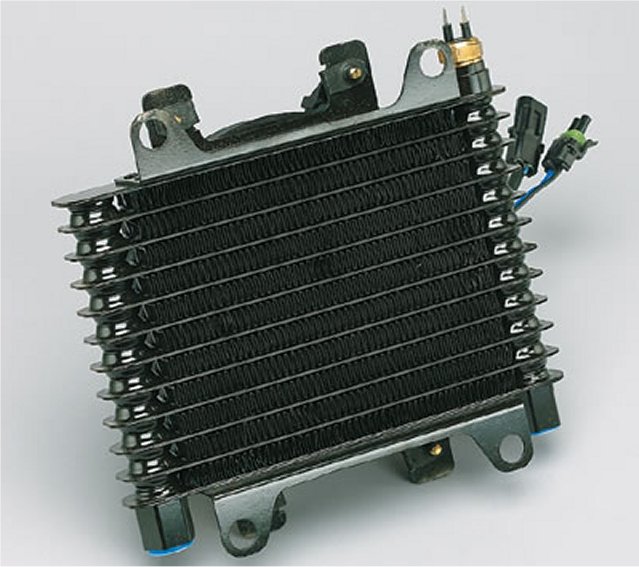
The second cooler is also a stacked plate model but comes equipped with a 12 volt fan. This setup is designed to make its own air flow to cool things down. This particular unit is slightly larger, with the core measuring 8.5″x6.5″x1.5″. The fan is thermostatically controlled and pushes air through the core at about 400 CFM when the fluid temp hits 175F degrees. The fan cuts off at about 160F degrees. Below that temperature, the fan is off. It is my hope, as I mentioned earlier, that the pre-cooler will keep the fluid temperature low enough so that fan use is kept to a minimum, at least while doing city/highway driving. The tranny fluid, upon leaving this cooler, is returned to the transmission. I ordered it from www.summitracing.com , part number BMM-70298. Cost was about $190.
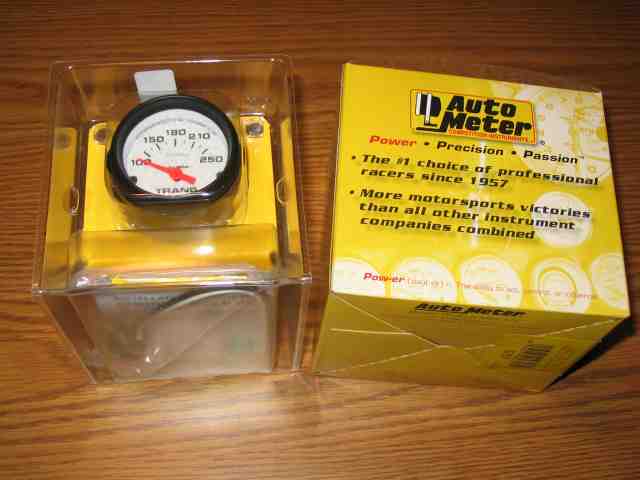
I’m not betting the farm on my two stage fluid cooling configuration without being able to monitor just what is happening. I picked up an Auto Meter transmission temperature gauge to take care of that task. Heat is the worst enemy of an automatic transmission since it will drastically shorten the useful life of the transmission fluid. Once the fluid has been overheated, your tranny suffers badly….it doesn’t take that long before major problems surface. This gauge comes with a remote sending unit that will be mounted in the tranny pan. That will give me a good idea of what the average operating temp is of the fluid. I picked up the gauge at a local performance shop. I saw them listed on the Summit Racing web site for about $45. The AutoMeter part # is 5757.
AW-4 Transmission Swap
T-Day (tranny install day) was sitting at T minus 6 and counting. I had made a checklist of things I needed to do before I put the TJ on the hoist for the actual swap. One by one, I was getting them checked off. I found myself with a bit of spare time so I decided it was time to clock the transfer case. I had helped ScottK re-clock his and wanted to get it out of the way before the swap was underway. The details are a little foggy from doing Scott’s, but I remember that we measured a LOT before drilling the holes. I think we made a paper template and then transferred the hole locations onto the AW4 mounting surface using a center punch. We had to use a round file on a couple of the holes to get all six bolts to properly fit, but it worked out just fine.
Update 01/22/2013: I found out today while talking with a friend that Iron Rock Offroad now sells a drilling jig for $45 that will allow you to drill your holes properly the first time. You can find it here.
I lucked out when it came time to drill the holes in my AW4. I had told Troy about having to re-clock the t-case when we were first telling him about the tranny swap. He got a big smile on his face and went over to one of the storage racks in the shop.
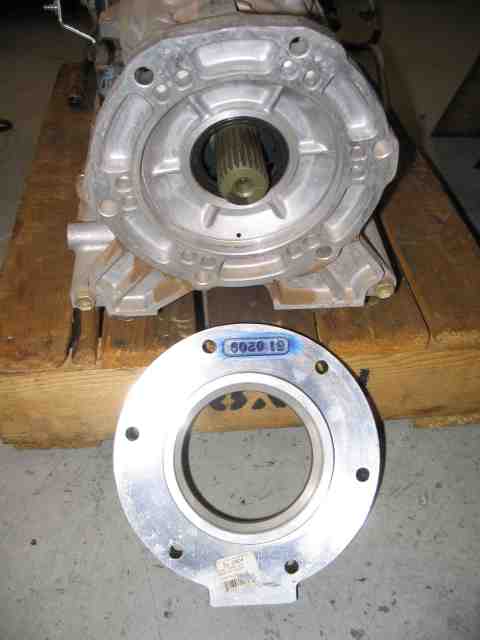
When he returned, he was holding an Advance Adapters spacer, part # 51-0404, made for a 4L60/Dana 300 combination. (The 4L60 is essentially a 700R-4 auto tranny.) Don’t even ask me why the hole pattern in the spacer actually fits that of my NP-231 transfer case, nor can I answer the question as to the spacer exactly fitting the recessed area of the AW-4. But suffice it to say that I was very glad to see that it did. I had at my disposal a “template” that was about 1″ thick and was a perfect match for the hole pattern I needed to transfer to the AW-4. It just don’t get any easier than this!

If you are going to do it, you might as well do it right the first time around. I grabbed a set of transfer bunches from the tool locker and found one that just slipped through the spacer’s hole. Transfer punches perform the same function as a regular center punch except that the body diameter of the punch is constant from one end to the other. There is a little tit on the bottom that actually does the marking/punching.

I made a pair of alignment marks on the AW-4 so I could determine proper placement once the spacer was put into place. The mark on the left indicates the centerline of where I want the new hole to appear. I only had to mark one hole since the spacer plate would located the remaining five holes correctly. You can see the mark on the edge of the spacer (top of photo) indicating the centerline of the hole.
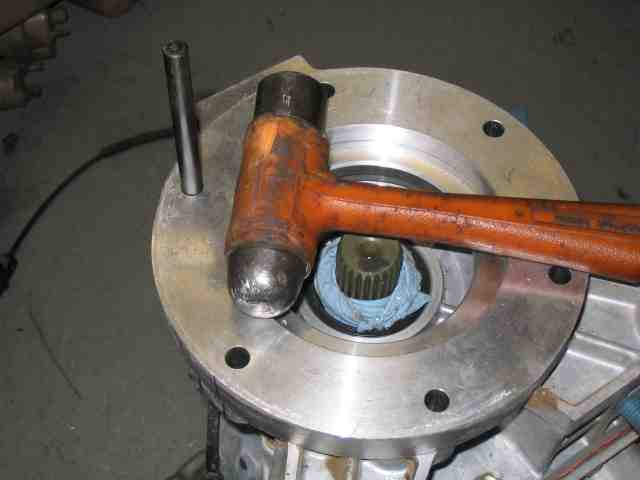
With the mark on the spacer aligned with the new hole mark on the AW-4, it was very easy to gently tap the transfer punch to mark the exact center for the 6 new holes. I used a small C-clamp to keep the spacer from moving as I was marking the holes (sorry, forgot to take a picture of it clamped in place).
With six nice newly marked holes properly located on the AW-4, I was down to the final step….drilling the holes.
At this point, I had two options available. I could unbolt the adapter housing from the back of the the AW-4 (which was what the 6 holes were just marked on). ScottK did this (you can see it here) and it worked just fine. Doing it in this manner should pretty much guarantee you that your holes are perpendicular and go straight through since you can put the adapter housing on the drill press table. When you are done drilling the holes in the adapter housing, you will need to reseal it when you bolt it back up to the transmission housing.
I opted for the second option, which was to drill it free hand (no help from a drill press). If you suck at this, you probably want to remove the adapter housing and use the drill press.
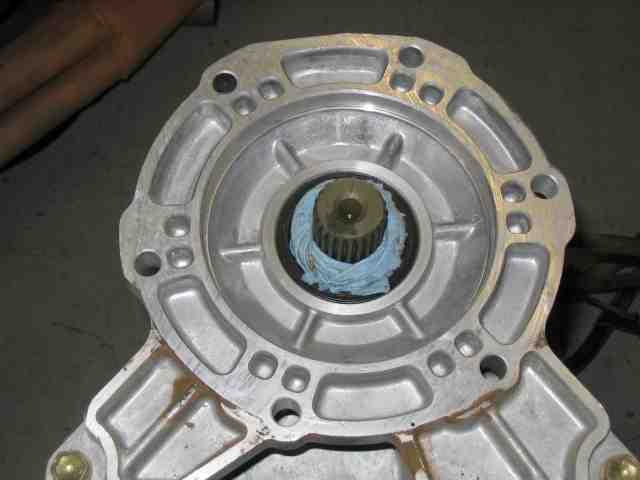
Prior to drilling, I took several heavy paper shop towels and packed them around the output shaft. Since the adapter housing was not being removed, I knew there would be metal filings all over the place before I was done. I did NOT want them down in the seal area.

The small hole in the above photo is the pilot hole I made first. I didn’t want to attempt the full size hole from scratch. I find it easier to control the smaller drill bit and then step up the hole size to the final dimension. In fact, I used three drill sizes when making these holes. The final drill size was 13/32″, just 1/32″ larger than the 3/8″ studs on the transfer case. That didn’t leave me much room for error (or clearance) but I figured I could bump the hole size to 7/16″ on any hole that didn’t line up correctly. No reason to remove more metal than is necessary. The original holes in the AW-4 (that were used in the XJ setup) were actually a fair bit larger than what I ended up making….maybe 1/16″ or there about.
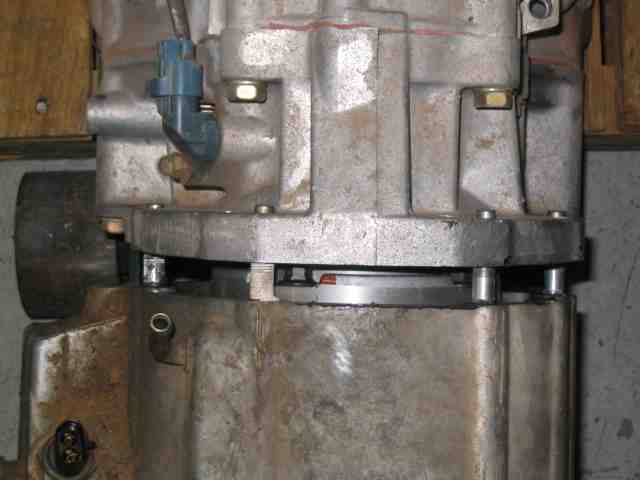
They say that the proof is in the pudding….but in this case, it will have to be the studs on the t-case fitting cleanly through the newly drilled holes in the AW-4. OH YEAH! Gotta love the way they line up. I should have bought a lottery ticket that day….I was on a role!
AW-4 Transmission Swap
As was mentioned at the beginning of this write-up, the AW-4 is an electronically controlled by a small TCU (computer) and as such, the swap entails having to deal with the electrical requirements of the transmission. Some folks are uncomfortable around electrical projects and struggle with the prospect of mounting a pair of driving lights on their vehicle. In all honesty, the electrical work for this swap is not all that daunting and if you can’t do this part of it, I’m confident you can find someone that can assist. Consulting your local 4×4 club should provide you with a body or two that can help with the wiring task.
Bob Bassett and Scott Kruize both did AW-4 swaps before I did and their efforts in documenting the wiring were very good. I got to help Scott do his swap and while he did the research for the wiring harness, I got the task of soldering it together. I remember reading through Scott’s notes and while very complete, they were a little confusing (not written the way I prefer wiring pinouts). I was also recently involved with some custom wiring on a Vortec V-8 swap into a TJ. That documentation was VERY poorly done and all that worked on the swap agreed. So….I promised myself that when I did this write-up, I would try to make a more user friendly (I hate that term but it applies here) wiring diagram. In speaking with Troy, he prefers a straight forward wiring list rather than a schematic. He said a “connect wire A to switch contact B” was easier to follow for him. So I put together a wiring list that contains the same information that ScottK provided in his write-up. It is my hope that you will find either Scott’s documentation or mine helpful. The important part is that you are comfortable following one of them so that your AW-4 project goes well.
Here is the wiring list for my swap. The first page contains the black and gray connectors for the wiring to/from the transmission itself. The second page contains the TCU connector. Scott’s AW-4 came from a 2000 XJ while mine came from a 2001 XJ. In both cases, the wire colors on the three electrical connectors were the same. Credit for the third page goes to Scott Bentley, another AW4 transplantee. (is that a word?) While we were discussing some of the details of this write-up online, it was suggested that a page covering the wire colors between the tranny and the black and gray plugs might be helpful. So that is the source and reason for page three.
Pages four and five of my wiring list are optional. I say optional because it is for making the wiring harness completely “plug ‘n play”. The 9 and 6 pin connectors are basically put in between the wires that connect the AW4 to the TJ. This means that the TJ will have a 9 pin and 6 pin connector soldered into its wiring harness too. The AW4 will have the matching 9 pin and 6 pin connectors soldered into its harness. When these two connectors are plugged together, all of the AW4 signals and TJ signals will be “cross connected”. This is the place in ScottK’s project where he used wire taps to connect the AW4 wiring into to the TJ. You do NOT have to do these two additional connectors in order to get everything to work correctly. I did them because I could and I wanted a little cleaner install under the hood. The choice is yours. I would suggest reading both ScottK’s and this write-up and then make up your mind as to how you want to do yours.
NOTE: On my wiring list, pages 1 and 2 assume that you will NOT be using the optional connectors listed on pages 4 and 5.
The wiring list for pages 1 and 2 is pretty straight forward. The connector/pin numbers on the left side of the list show the “FROM” location and the connector/pin numbers on the right side of the list shows the “TO” location. Read across one row and you will connect a wire FROM there TO here. Pretty easy, eah? If you are mildly interested (and you should be) as to what it is you are connecting, the middle column provides a description/function of that wire. Note that not all pins in all connectors are used (some are blank).
The important thing to remember when doing electrical work is to take your time and do it correctly the FIRST time. Having to go back a second or third time becomes a pain in the neck (or worse). Double check yourself several times as you locate each wire on the connector and confirm it is the correct color you are going to be soldering. Spending the extra time while constructing the wiring harness will save you a lot of time trying to diagnose a shifting issue later on.
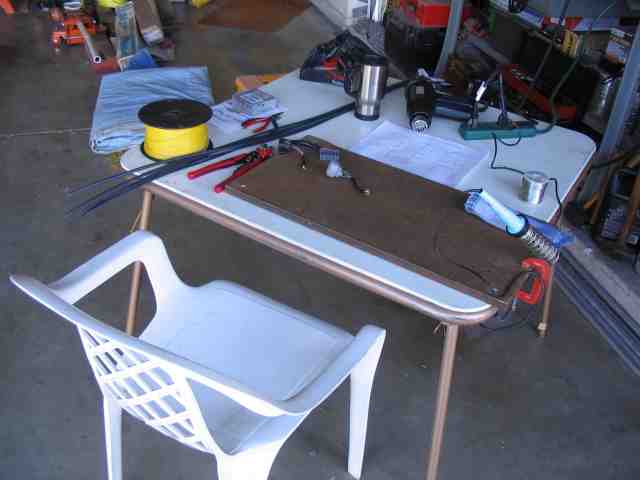
This this will take several hours to do properly (in my opinion), so you might as well get yourself comfortable. I grabbed a folding table (my wife doesn’t let me solder on the dining room table…..any more), a patio chair, and a piece of scrap particle board (much harder to destroy with a hot soldering iron than the actual table top).
A good soldering iron (or low wattage soldering gun) and a roll of rosin core solder is needed for good electrical connections (do NOT use acid core solder, like the kind used for plumbing projects!). I picked up a new wire stripper from Radio Shack just for this occasion (about $15) and I am happy to report that it worked very well. I wish I would have gotten it long ago! I also picked up several 4′ lengths of heat shrink tubing. I got tubing sizes in both 1/8″ and 3/16″ diameter. It costs about $1.50 per length so budget yourself a few extra dollars for this part of the project.
On major projects, I always try to add a little something to the tool box. While I could have used the new wire strippers to satisfy this requirement, I’ve always wanted a heat gun. I found one at Fry’s Electronics (where I bought the 4′ lengths of heat shrink) for $30. It is a dual temp (500F and 1000F) model and I’ll tell you now that it worked very well….my heat shrinking days of using a BIC lighter are long gone.
I had spent some time the previous day with a tape measure while under the hood of the TJ. I decided that I needed about 5 feet of harness to go from the end of the black and gray tranny connectors to the TCU connector. Since the TCU is not at all waterproof, I opted to mount it inside the vehicle. This goes along with it being mounted inside the XJ as well. I also prefer to have a little extra cabling rather than not enough, so my measurements take that into consideration as well. My advice is for you to select the TCU mounting location and then use a tape measure to determine the cable length that works for your needs.
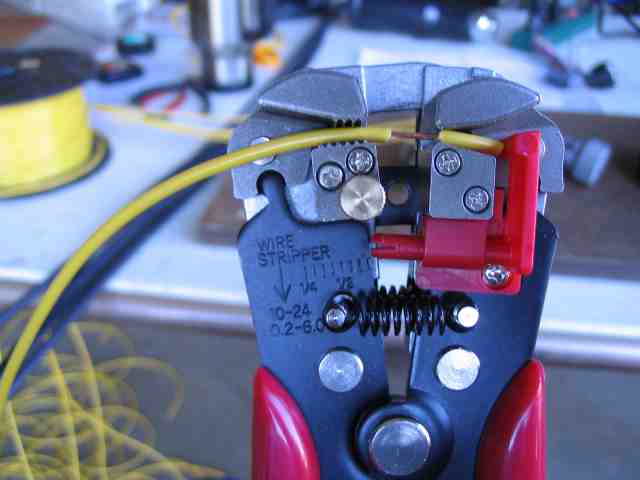
With the necessary length now determined, I sat down with my brandy new wire strippers and stripped a couple dozen lengths of wire. I adjusted the stripper to remove 1/2″ of insulation. It worked very nicely! I find it easier to do a bunch of the same steps repeatedly, such as stripping the wire….saves all that time of putting down one tool and picking up the next, over and over and over. OK….so I now have a good supply of wire.
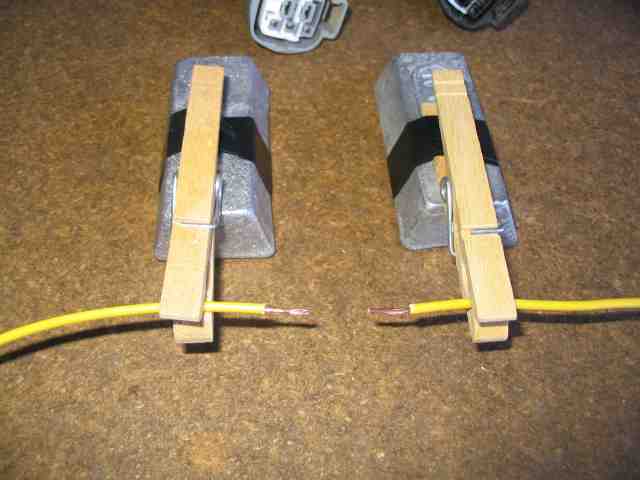
They say that necessity is the mother of all inventions. That being said, I quickly found out that I needed a third (and forth) hand to hold the wires in place while I soldered them together. I stole two clothes pins from Donna’s laundry room and grabbed a couple of 1 pound lead ingots from my reloading bench. A couple of wraps of electrical tape (sorry, the duck tape was all packed away in the TJ’s rear storage box) and my third and forth hands were ready to help. The lead bar is heavy enough to keep things nice and steady (no sliding around). A brick would have worked too but I’m not sure my old card table could have survived.

Be smart! Don’t forget to slide the heat shrink tubing over the wire BEFORE you make the connection (especially if you have a connector already attached to the other end of the wire). Hey, I only did it ONCE during the entire soldering episode….not too bad in my opinion!
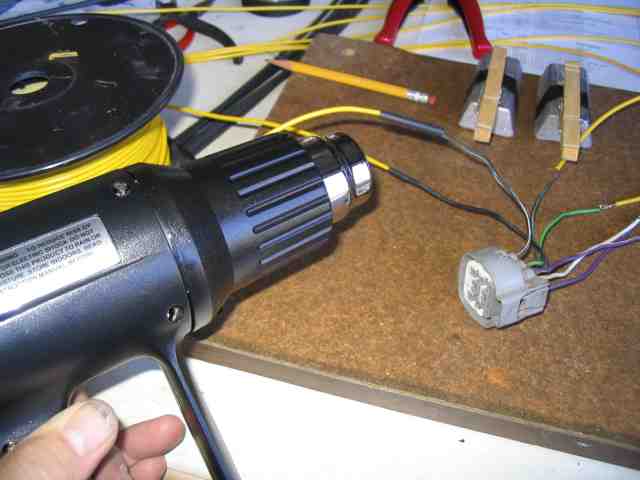
After a couple of connections were soldered, I would fire up the heat gun and shrink the tubing. That too worked very nicely. I think I am going to enjoy electrical projects much more than I have in past years. You can see the wire extensions being added to the gray connector in the above photo.
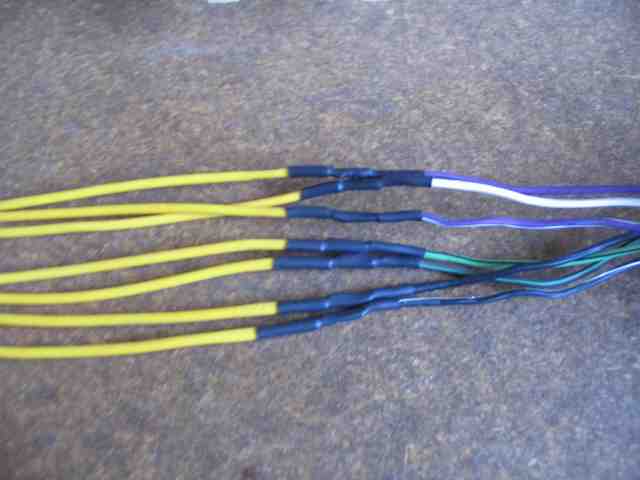
A group of wires successfully attached to one of the 8 pin connectors. After I finished the first connector, I started taping the wires together once I had 3 or 4 wires completed. It was starting to turn into a rats nest of twisted wires and that only leads to making mistakes and an overall messy work space.
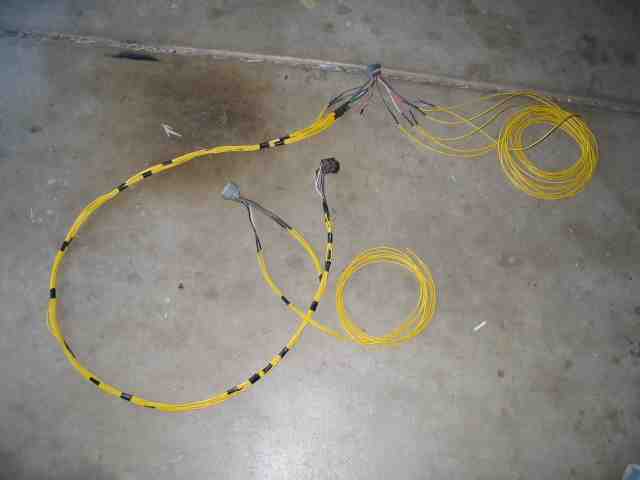
Here is the harness after a couple of hours of work (not yet completed). The two coils of wire will be finished later on this week when I get some more time. They are the wires that will be going to the TJ’s wiring harness. The 9 pin Molex connectors I got at Radio Shack will be used for this section of the harness (pages 4 and 5 of the wiring list). Once it is all completed, I’ll wrap it completely in electrical tape and then slip a plastic wire loom over it to prevent any abrasion.
AW-4 Transmission Swap
OK, it is now later in the week and time to identify/locate the physical wires in the TJ’s wiring harness that will be interfaced to the AW4 wiring harness. Assuming you already looked at my wiring list, you should have noticed that some of connections go to various TJ wires to provide +12V, ground, throttle position, brake pedal switch, etc.
After looking at the various connections that were needed, I opted to tap into the TJ wiring harness near the PCM (Powertrain Control Module). This is one of those times when a factory service manual is very good to have available. There is a plethora of information contained in the wiring diagram section.
One thing I noticed, when reviewing ScottK’s write-up, was the difference in the PCM connector designations between his diagrams and mine. At first, it kind of threw me for a loop and then I realized his pin-out diagrams were that from the XJ service manual while mine were obviously from my TJ manual. While the signal functions and wire color are the same, the actual connector designators are different between the two vehicles.

The connectors on my 98 TJ’s PCM has three plugs (as all do) and they are different colors; gray, white, and black (shown left to right in the above photo). In my wiring list, I listed the connector color as this seems less confusing than using the C1, C2, and C3 that they are also known by in the factory service manual (and which conflicts with the designators that ScottK used in his write-up). Again, this is where having a factory service manual for your year vehicle really pays off.
Rather than try to chase the wires around the vehicle’s wiring harness, I opted to tap into the necessary wiring fairly close to the PCM connectors.
Note: Time to disconnect the negative leads from the battery if you have not already done so.
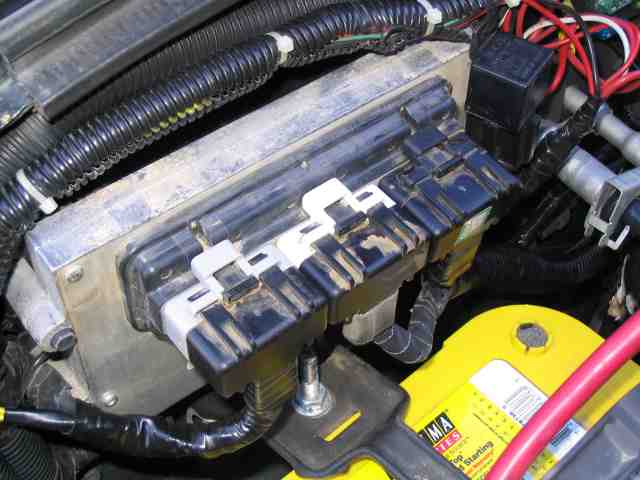
Here is a picture of the black plug disconnected from the PCM. As you can see, the pins are numbered, which makes it pretty simple to reference this end of the connection.
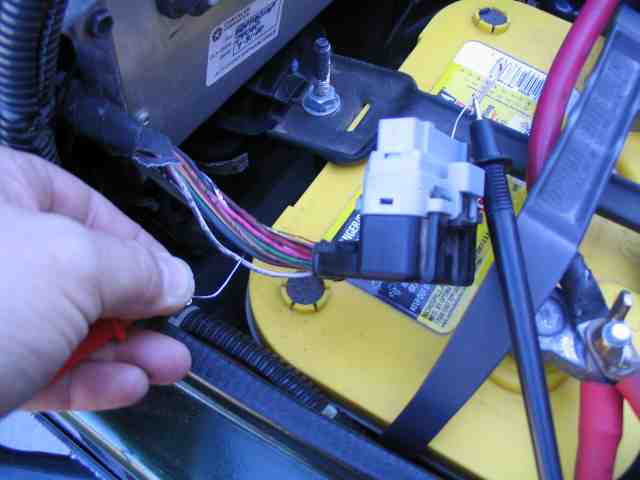
I used an ohm meter to positively identify the wire in the harness. Since my test leads were too large to fit into the connector, I used a paper clip to make contact with the connector pin. I used another paper clip that had been sharpened to a fine point. It easily pierced the insulation on the wire I wanted to test. So with the paper clip inserted into the correct pin on the connector (and the meter lead attached to the paper clip), I located and identified the wire by its color and then checked that by testing it with the ohm meter. A short (0 ohms) tells me I have located the correct wire in the wiring harness.
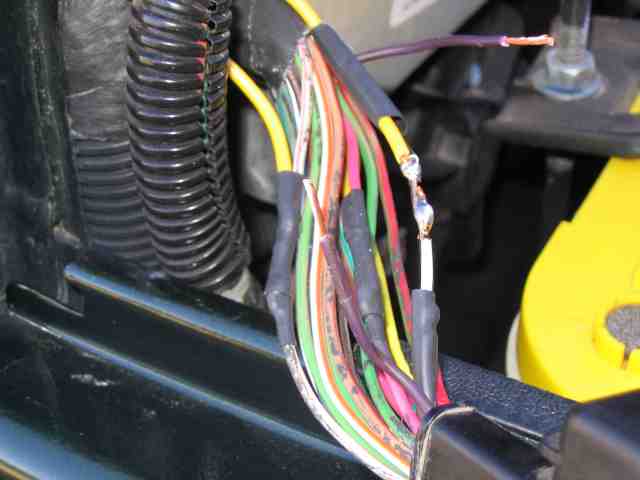
With the wire properly identified, I cut it in half, stripped the ends back about 1/4″, and then spliced the new wire into the connection. I used heat shrink tubing to seal up the new connection. (Make sure you slide the heat shrink onto the ends of the wires BEFORE you solder them together.)

Here are the 4 splices made at the base of the gray PCM connector. Nice and neat, minimal impact on the remaining wires in the harness. As each splice was completed, I attached a label to the wire indicating the pin that it was connected to. When all of the splices were complete, and the vehicle wiring harness was re-taped, I was able to identify each wire by the attached label.
AW-4 Transmission Swap
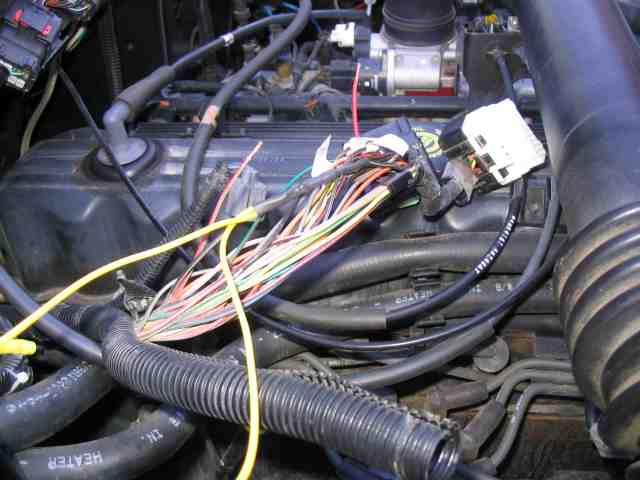
The connections going to the black PCM connector were done in the same fashion as the gray connector. The white and black plugs share the same main wire harness and it is quite a bit larger than the harness going to the gray connector. As such, you have to dig through the wire harness a bit more to find the correct wires for the splice. I removed the plastic loom material for about a foot and stripped off the tape so I could access the wires. I used the ohm meter to ensure I had selected the correct wire, then cut it, stripped it back, then soldered the splice wire. As before, heat shrink tubing was used to seal up each connection.
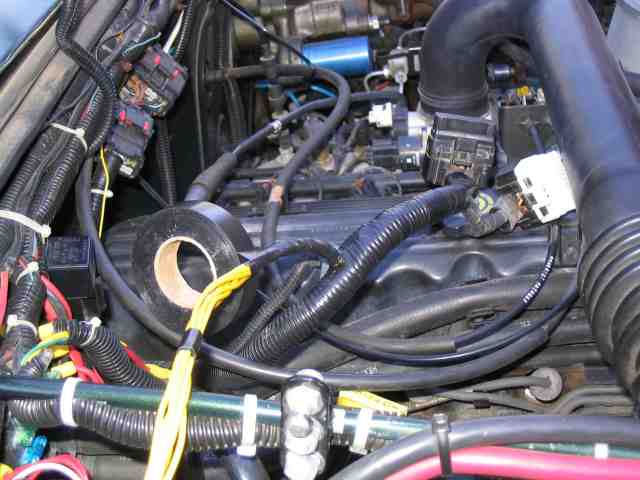
With the splices all complete, I used electrical tape to patch up the area where I had to remove the factory wrap on the wire harness. I also taped together the sliced wires where they came out the TJ wire harness. From here, they go to a couple of connectors that turn this into a plug and play setup. (more on to follow) Take your time and it should come out just fine.
When we built the AW-4 harness for ScottK’s TJ, the connections were made directly between the two harnesses. While this worked and was very reliable, it made it difficult if you wanted to isolate a wire for troubleshooting purposes. Likewise, if you ever had to remove the AW-4 harness for some reason, it meant you had to go in and either cut or unsolder the wires from the TJ harness.
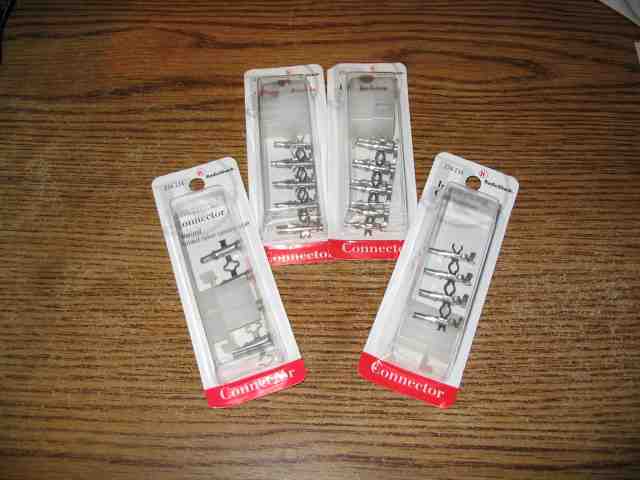
I wanted a little more flexibility in my configuration. A visit to the local Radio Shack store provided just what I needed. I purchased two pairs of connectors, a 9 pin male (# 274-229) & 9 pin female (# 274-239), and a 6 pin male (# 274-226) & 6 pin female (# 274-236). I would use the 6 pin connector to make the CCD + and – and SCI transmit connections between the TCU and the TJ. Since ScottK determined these cause the check engine light to illuminate when you use the shifter, this plug will normally be disconnected. If I want to to query the TCU with the OBDII scanner, I can connect the two plugs. The 9 pin connectors will be used to connect the remaining wires from the TCU and the transmission range sensor (gray plug).
Note: The above plugs are those referenced on pages 4 and 5 of the wiring list.
Note: I originally bought a 4 pin male & female connector, but the male connector came with the wrong diameter pins. As such, the two connectors would not plug together. So, it was back to Radio Shack to exchange them for the 6 pin versions. I’ll have three unused pins in the connector.
Oh Oh…..but don’t worry!
This website started back in the late 1990’s and has experienced several makeovers since then. At the same time, thousands of site readers left their favorite links all over the internet pointing to their favorite pages here on the site. While I’ve tried to keep things in order, some pages were ultimately relocated in order to make more sense of the site’s content and keep it more organized. Rest assured, the page was not deleted but just moved.
To find your page, click on one of the above navigation links to take you to the topic area you were looking for.
Or….you can use the dedicated site search feature below to quickly find it too. If you were following an old link to get information, perhaps about control arms, enter control arm in the search window.
